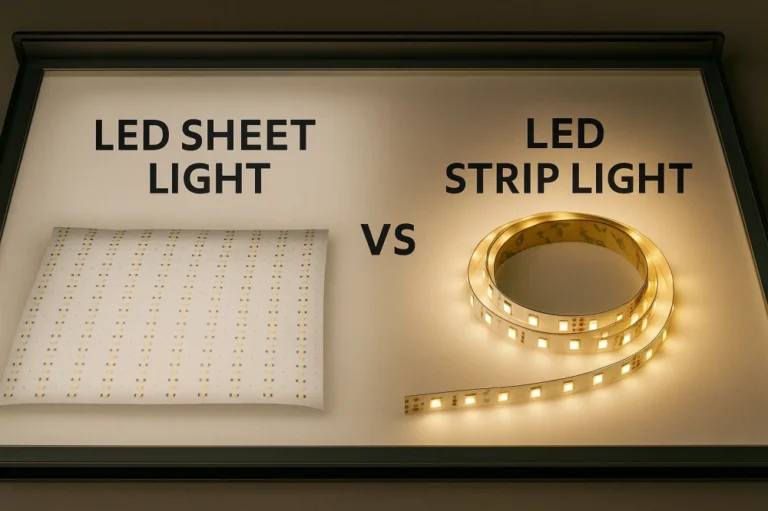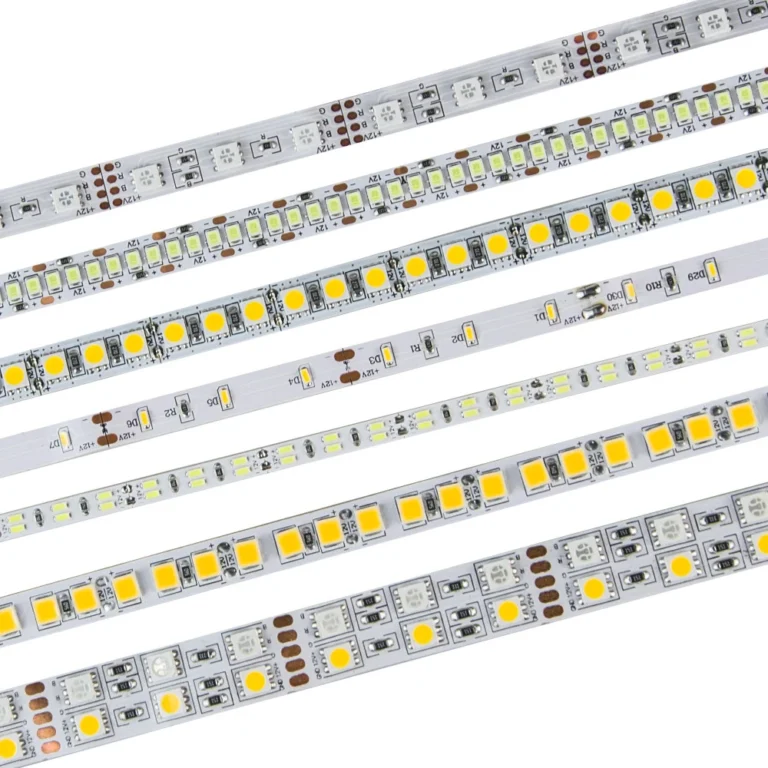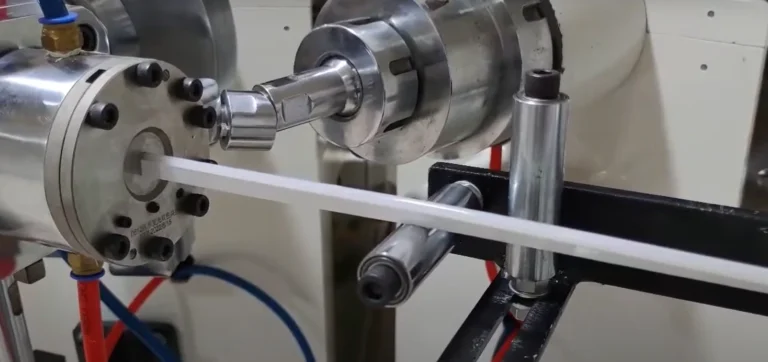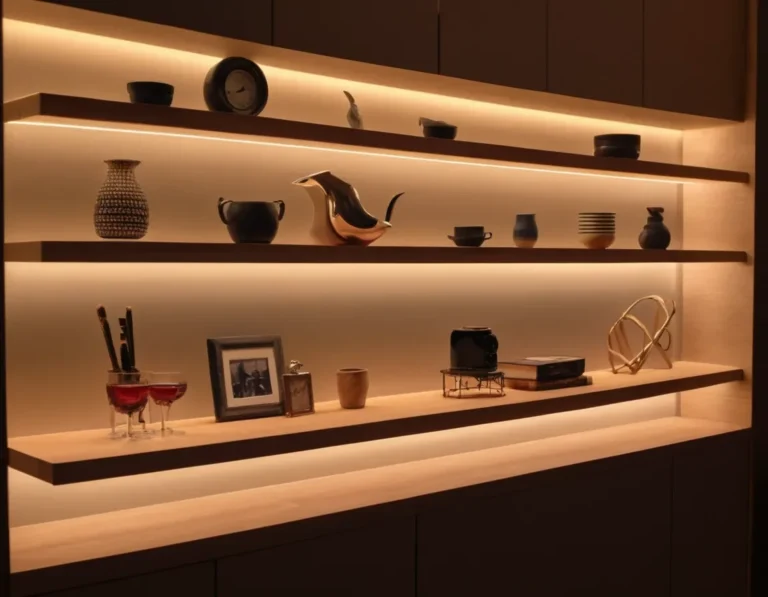Le strisce LED sono disponibili in una varietà di larghezze, lunghezze e tipi di chip LED, rendendole versatili sia per applicazioni di illuminazione residenziale che commerciale. Quando si tratta di progetti di illuminazione, scegliere la larghezza giusta per le strisce LED può essere un vero grattacapo. Ti sei mai sentito sopraffatto dal compito di scegliere la dimensione appropriata per la tua striscia LED? Diamo un'occhiata più da vicino alle diverse opzioni di larghezza per trovare la striscia perfetta per le tue esigenze di illuminazione.
Le strisce luminose a LED sono disponibili in un'ampia gamma di dimensioni e larghezze. Le strisce luminose a LED a fila singola hanno in genere larghezze che vanno da 3 a 15 millimetri. Al contrario, le strisce luminose a LED a più file possono raggiungere larghezze fino a 120 millimetri. Scegliere la larghezza appropriata di una striscia luminosa a LED è fondamentale per garantire una corretta dissipazione del calore, un'installazione flessibile e altri fattori. Inoltre, le dimensioni dei chip LED o SMD sono un altro fattore chiave che influenza la larghezza delle strisce luminose a LED.
Capire come ogni larghezza di striscia LED influisce sull'installazione e sulle prestazioni è fondamentale per fare la scelta giusta. Approfondiamo i dettagli!
Qual è la larghezza di una striscia luminosa a LED?
La larghezza di un Striscia luminosa a LED Si riferisce alla sua larghezza fisica, in particolare alla larghezza del PCB (circuito stampato). La struttura di una striscia LED è costituita da più LED disposti in uno schema regolare su un circuito flessibile (PCB). Pertanto, la larghezza di una striscia LED si riferisce essenzialmente alla larghezza del PCB, tipicamente misurata in millimetri (mm), che indica le dimensioni del materiale di base della striscia.
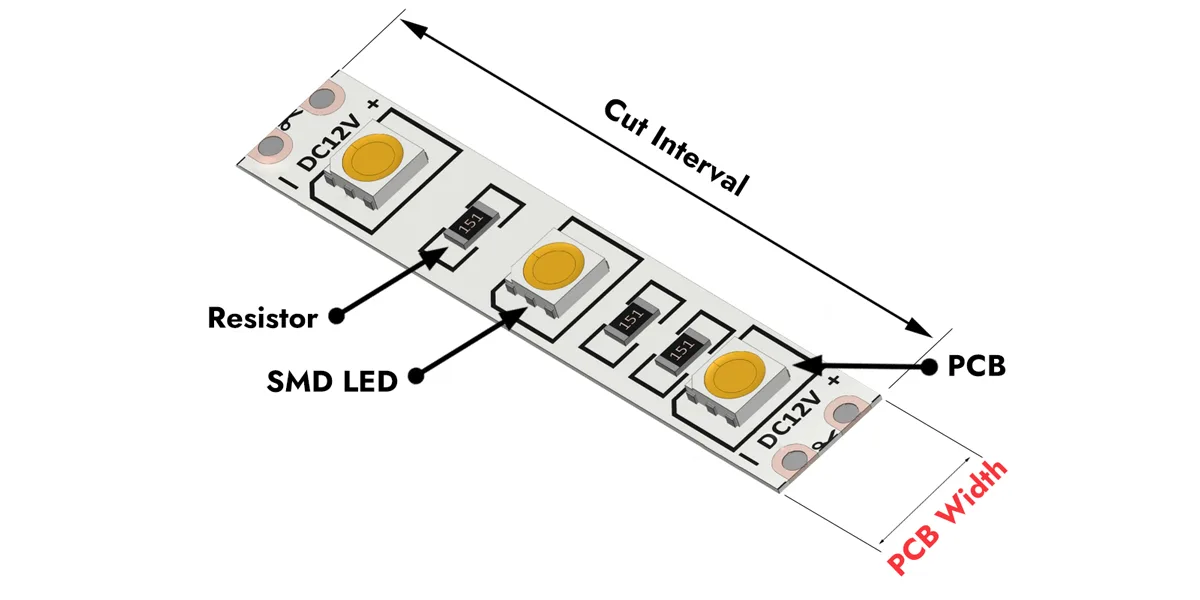
Nella scelta e nell'installazione di strisce luminose a LED per vari progetti, la larghezza della striscia è un fattore importante. Le strisce più larghe possono in genere ospitare più LED, offrendo un'illuminazione più brillante e una migliore dissipazione del calore, mentre le strisce più strette possono essere più adatte per installazioni con spazio limitato o requisiti di design specifici.
È importante notare che le larghezze delle strisce LED variano. Ad esempio, le strisce LED a fila singola presentano una sola fila di chip LED per tutta la loro lunghezza, con larghezze che in genere vanno da 1 mm a 15 mm. Le strisce LED a fila multipla, invece, presentano più file di chip LED sull'intero PCB. Questo le rende più larghe delle strisce LED a fila singola, con larghezze che raggiungono fino a 120 mm. Queste strisce LED possono essere a doppia, tripla, quadrupla, cinque o più file.
Naturalmente, tutte le larghezze e il numero di file di LED sono personalizzabili, a seconda del produttore e dell'applicazione prevista.
Perché considerare la larghezza delle strisce luminose a LED?
La larghezza delle strisce luminose a LED è un fattore critico. Scegliere la larghezza appropriata non è solo una questione estetica, ma influisce anche in modo significativo su luminosità, illuminamento, dissipazione del calore, spazio occupato e flessibilità di installazione. Analizziamo i motivi specifici.
1. Luminosità e illuminamento: La larghezza di una striscia LED influisce sulla sua luminosità e sull'illuminazione complessiva. Le strisce più larghe in genere ospitano più LED, con conseguente maggiore emissione luminosa, ma consumano anche più energia. Se si necessita di un'illuminazione intensa, strisce più larghe potrebbero essere più adatte. Al contrario, strisce più strette possono produrre una luce più morbida o più concentrata.
2. Dissipazione del calore: Le strisce luminose a LED generano calore durante il funzionamento. Trasferire il calore generato dai LED al circuito stampato (PCB) e dissiparlo nell'ambiente circostante è fondamentale per mantenere la striscia luminosa fresca. In questo caso, le strisce luminose a LED più larghe possono fungere da dissipatori di calore, assorbendo e dissipando il calore generato dai LED. Rispetto ai circuiti stampati (PCB) più stretti, i circuiti stampati (PCB) più larghi sono più efficienti.
3. Progettazione ed estetica dello spazio: Le strisce luminose a LED sono comunemente utilizzate per l'illuminazione decorativa o d'accento. La larghezza della striscia luminosa a LED influisce sull'aspetto visivo dell'intero spazio e sulla sua integrazione con il design generale. Ad esempio, strisce luminose più larghe possono essere più adatte a creare effetti audaci e accattivanti, mentre strisce luminose più strette possono creare un aspetto più minimalista o sobrio.
4. Flessibilità di installazione: Se lo spazio di installazione è molto stretto, installare strisce luminose a LED più larghe potrebbe risultare complicato. Pertanto, è fondamentale verificare la larghezza delle strisce luminose a LED per assicurarsi che si adattino allo spazio di installazione. Inoltre, le strisce più strette sono più adatte ad angoli o bordi, poiché possono essere facilmente piegate.
5. Compatibilità degli accessori: La larghezza delle strisce luminose a LED è fondamentale per garantire la compatibilità con le staffe di montaggio, Connettori LED, E altri accessoriQuesti accessori sono in genere progettati per adattarsi a specifiche larghezze di strisce luminose, quindi la scelta della larghezza appropriata garantisce una buona connettività e una facile installazione.
6. Compatibilità dei canali LED in alluminio: Quando si aggiunge canali in alluminio o diffusori in silicone per strisce LED, la larghezza della striscia luminosa è un fattore critico. L'aggiunta di canali per strisce LED può fornire un'emissione luminosa morbida e uniforme, ma se la larghezza della striscia non è ideale, potrebbero sorgere problemi di installazione. In questi casi, è necessario valutare la compatibilità tra il diametro interno del canale e la larghezza della striscia LED. Ad esempio, una striscia LED da 10 mm non può essere installata in un canale in alluminio da 5 mm o in un diffusore in silicone. Per ulteriori informazioni sui profili in alluminio per LED, consultare "Profilo in alluminio per illuminazione a strisce LED.”
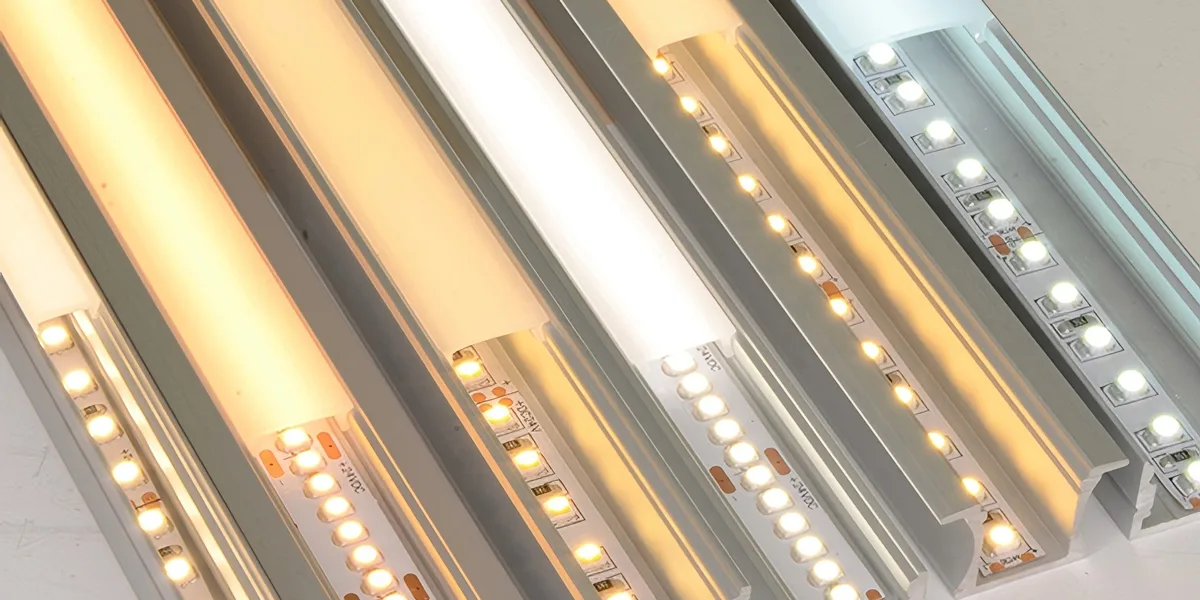
Quali sono le larghezze standard per le strisce luminose a LED?
Le larghezze standard più comuni per le strisce LED sono 8 mm, 10 mm e 12 mm. Queste sono anche le tre larghezze più utilizzate. La larghezza delle strisce LED varia a seconda della marca e dipende anche dal tipo di striscia LED e dalle dimensioni dei chip LED.
Strisce LED da 8 mm: Le strisce LED da 8 mm sono ideali per l'installazione in aree strette e poco visibili, rispondendo alla crescente domanda di illuminazione d'accento, illuminazione sottopensile o illuminazione di mobili. Una larghezza così ridotta può soddisfare l'esigenza di un'illuminazione discreta senza occupare troppo spazio. Questa larghezza consente infinite applicazioni creative, come l'installazione all'interno di mobili o lungo le scale, dove lo spazio per l'illuminazione è limitato. La scarsa visibilità della striscia luminosa migliora l'effetto luminoso senza compromettere l'arredamento generale.
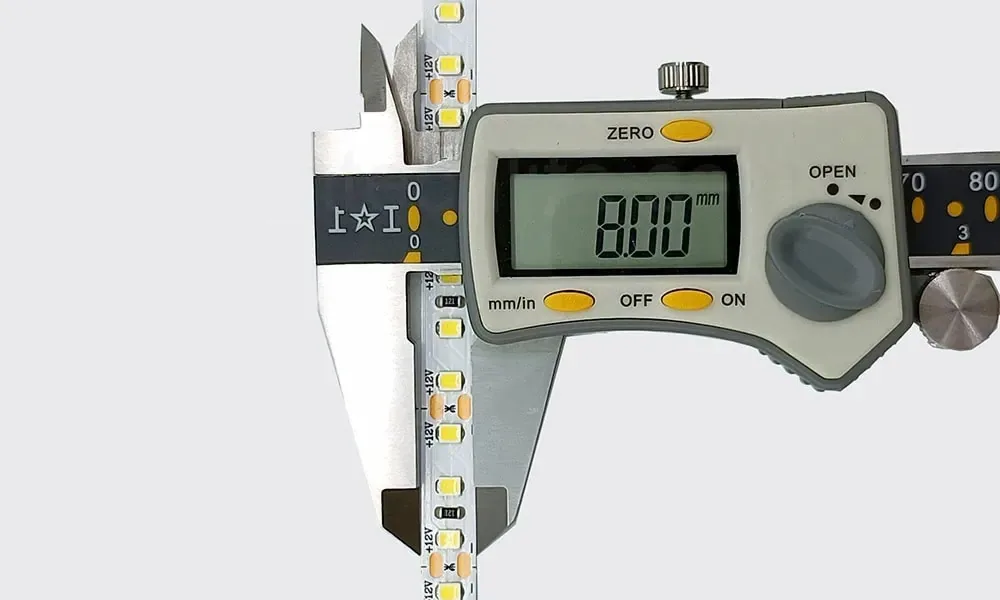
Strisce LED da 10 mm: Le strisce LED da 10 mm sono generalmente utilizzate per progetti di illuminazione generale. Offrono un'elevata luminosità e sono comunemente utilizzate nell'illuminazione architettonica, nell'illuminazione di nicchie e negli apparecchi di illuminazione decorativa per applicazioni residenziali e commerciali. Inoltre, che si tratti di illuminazione d'accento in abitazioni o di illuminazione funzionale in negozi al dettaglio, le strisce LED da 10 mm possono adattarsi facilmente a diversi ambienti di utilizzo. Questa versatilità si estende alle opzioni di colore, con molte strisce LED da 10 mm che offrono versioni RGB e luce bianca regolabile, consentendo agli utenti di personalizzare l'illuminazione in base alle proprie preferenze.
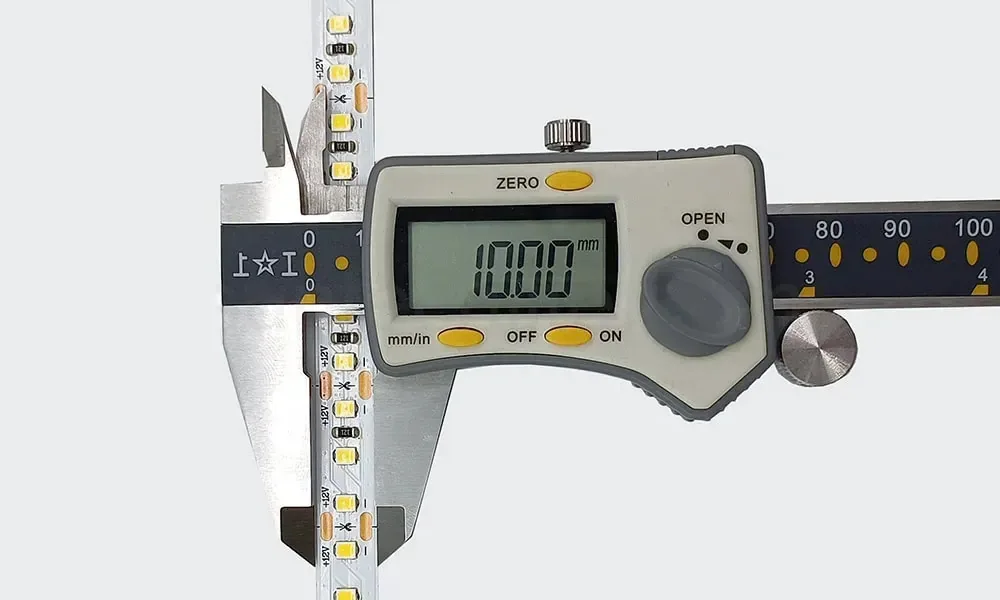
Strisce LED da 12 mm: Le strisce LED da 12 mm sono leggermente più larghe e in genere offrono una maggiore emissione luminosa. Sono comunemente utilizzate in applicazioni che richiedono soluzioni di illuminazione più luminose e potenti, come l'illuminazione per esterni o installazioni su larga scala. Questa larghezza consente una maggiore densità di LED, luminosità e una distribuzione uniforme della luce. Le strisce LED da 12 mm sono ideali per l'illuminazione architettonica, principalmente perché in quest'ambito la combinazione di estetica e funzionalità è fondamentale per evidenziare le caratteristiche principali e creare punti di interesse.
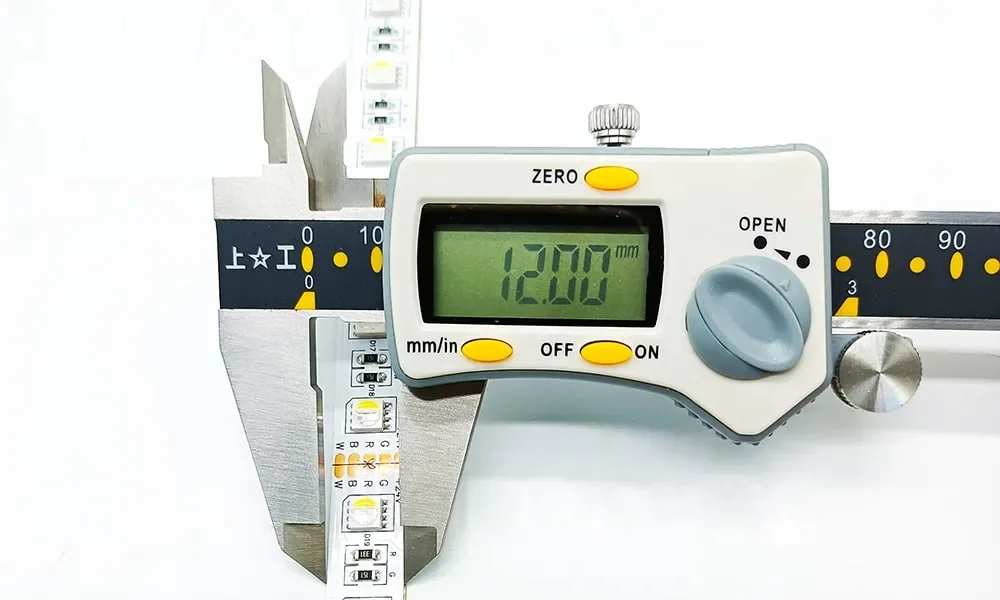
Strisce LED da 15 mm e più larghe: Le strisce LED da 15 mm e più larghe offrono una maggiore densità di LED e luminosità. Sono adatte per l'illuminazione commerciale e per installazioni su larga scala. Queste strisce forniscono un'illuminazione uniforme con ombre minime, rendendole ideali per progetti architettonici e di segnaletica. Le strisce più larghe possono ospitare più LED e favoriscono una migliore dissipazione del calore, fondamentale per prevenire il surriscaldamento durante l'uso prolungato. Pertanto, sono adatte per ambienti professionali in cui la costanza di prestazioni e l'affidabilità sono fondamentali.
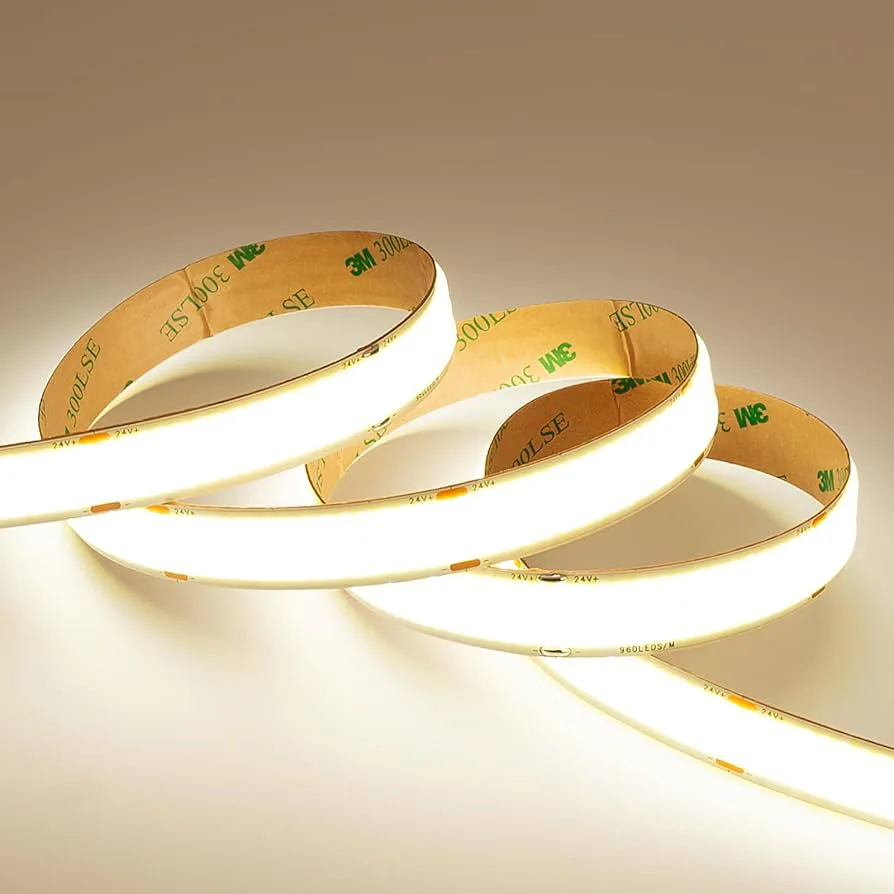
Striscia LED COB ultra luminosa senza punti da 15 mm di larghezza
Modello: Modello FYX15T1920C
Quantità di chip LED al metro: 1920chips
CRI: >90
Larghezza PCB: 15 millimetri
Temperatura del colore: 3000K/4000K/6000K
Tensione di ingresso: DC24V
Potenza al metro: 25W
Lunghezza tagliabile: 20,67 mm
Versione impermeabile: IP20/IP65
Garanzia: 3 anni
Strisce LED ultra-sottili: Le strisce LED con larghezze di 3 mm, 4 mm e 5 mm sono generalmente chiamate strisce LED ultra-sottili, il che le rende perfette per esigenze di illuminazione ultrasottili e discrete. Le loro dimensioni compatte consentono una facile installazione in spazi ristretti, come bordi di mobili, vetrine e strutture architettoniche. Queste strisce sono ideali per design minimalisti, dove la sorgente luminosa è nascosta pur fornendo un'illuminazione pulita ed elegante.
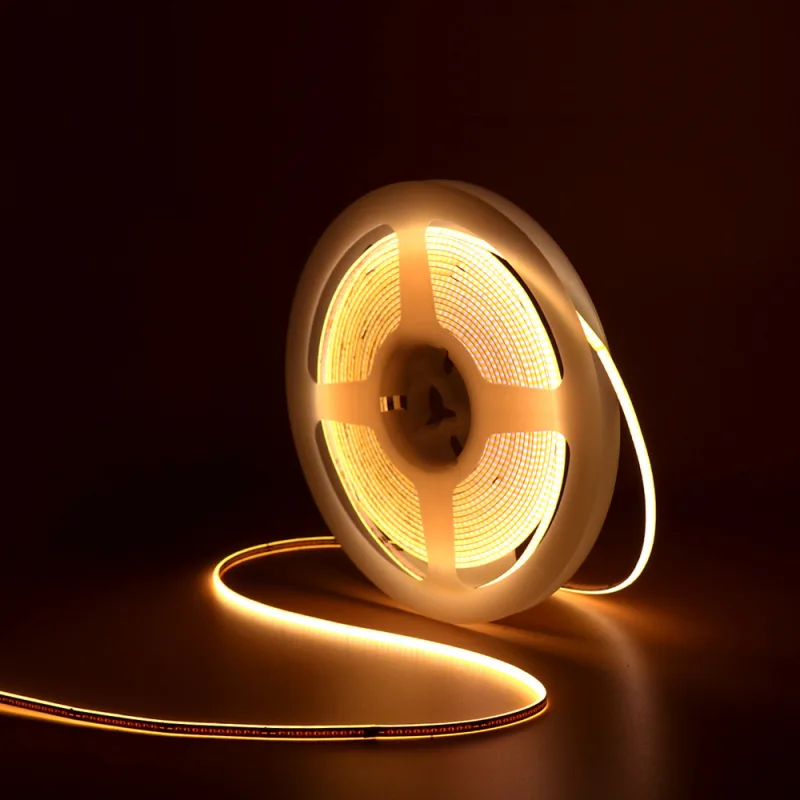
Striscia LED COB ultra stretta
Modello principale: Modello FYX04T400C
Quantità LED al metro: 400 patatine (Sanan)
Opzione larghezza PCB: 3 mm/4 mm/5 mm
Opzione colore: 2700K/3000K/4000K/6000K
CRI: >90
Tensione di ingresso: DC5V/DC12V/DC24V
Potenza al metro: 5,5 W/10 W
Efficienza: 90–110 lumen/watt
Opzione grado IP: IP20/IP54/IP65/IP67/IP68
Garanzia: 3 anni

Molte persone si pongono una domanda comune: tutte le strisce LED hanno la stessa larghezza? La risposta è no. Per soddisfare i diversi requisiti applicativi, non tutte le strisce LED hanno la stessa larghezza del PCB. In spazi di installazione ristretti, come all'interno di armadi, le strisce LED più larghe sono difficili da nascondere a causa dello spazio limitato. Se si desidera integrare l'illuminazione a LED in spazi ristretti, è possibile utilizzare strisce LED più strette. Pertanto, il design delle strisce LED di larghezza spesso soddisfa le diverse esigenze degli utenti.
Quindi, la larghezza delle strisce LED è importante? In effetti, per aree di installazione spaziose, la larghezza delle strisce LED non è fondamentale. Invece, la densità e la luminosità delle strisce LED sono più importanti, poiché le aree spaziose in genere richiedono una maggiore luminosità per illuminare i dettagli. Solo negli spazi con limitazioni di larghezza, la larghezza delle strisce LED è fondamentale.
In sintesi, ogni larghezza di striscia LED offre vantaggi unici per diverse applicazioni, garantendo che il vostro progetto di illuminazione combini funzionalità ed estetica. Di seguito sono riportate alcune larghezze di strisce LED a vostra disposizione.
| IOtemi | Striscia LED 2835 Larghezza | 5050 Striscia LED Larghezza | PANNOCCHIA Striscia LED Larghezza |
| Fila singola | 5 mm, 6 mm, 8 mm, 10 mm, 12 mm | 10 mm, 12 mm, 14 mm, 15 mm | 3 mm, 4 mm, 5 mm, 8 mm, 10 mm, 12 mm |
| Doppia fila | 15 mm, 20 mm | 15 millimetri | 12 millimetri |
| Tripla fila | 16 mm, 22 mm, 32 mm | 32 mm, 58 mm | 12 mm, 20 mm |
| Quad Row | 28 mm, 30 mm | N / A | 15 mm, 20 mm |
| Cinque file | 64 millimetri | 58 millimetri | 30 millimetri |
| Otto file | N / A | 120 millimetri | N / A |
L'altezza delle strisce luminose a LED influisce sull'installazione?
Nella scelta delle strisce LED per diverse applicazioni, oltre alla larghezza, anche l'altezza è fondamentale. Le strisce più spesse potrebbero non essere adatte a design compatti o spazi ristretti, limitandone così l'utilizzo in installazioni a incasso o a superficie. Le strisce LED ultrasottili sono la scelta ideale per design eleganti e sobri, poiché possono essere facilmente installate in spazi ristretti o poco profondi, rendendo l'installazione più pratica.
IP20 (non impermeabile): Altezza circa 1,5 millimetri. Queste strisce luminose a LED sono estremamente sottili a causa della loro mancanza di impermeabilità. Sono adatte per l'installazione in ambienti interni asciutti, come sotto i mobili o come illuminazione d'accento.

IP65 (rivestito in silicone): Altezza 2-3 millimetri. Queste strisce luminose sono ricoperte da uno strato di silicone, che le rende leggermente impermeabili. Pertanto, sono ideali per cucine, bagni o qualsiasi ambiente leggermente umido.
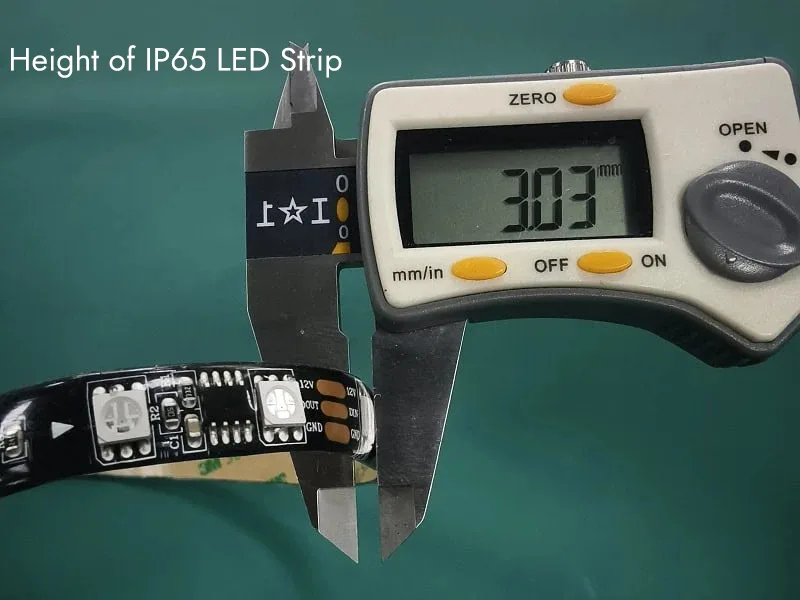
IP68 (sigillatura con tubo in silicone): Altezza: 5-8 millimetri. Le strisce luminose a LED IP68 sono completamente incapsulate con silicone resistente o resina epossidica. Le strisce luminose a LED IP68 sono ideali per applicazioni esterne e subacquee, tra cui fontane e illuminazione paesaggistica.
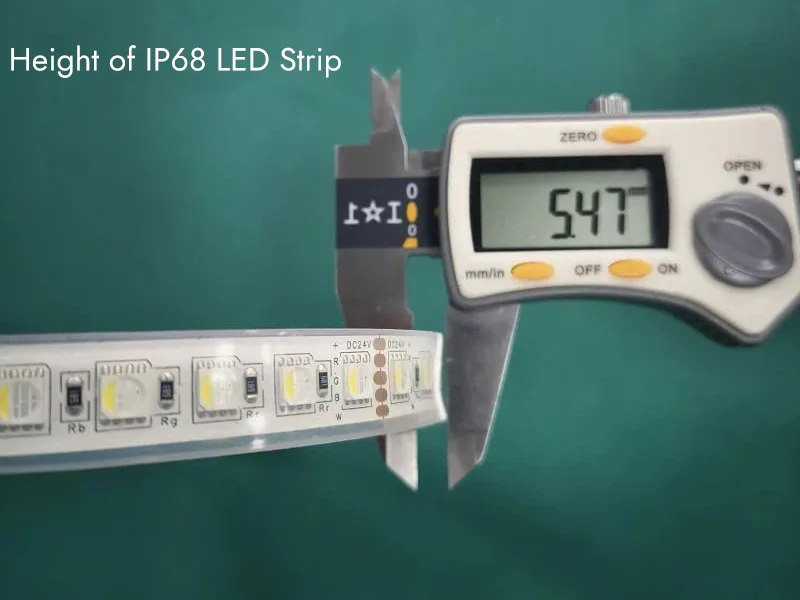
Per maggiori informazioni sulle strisce luminose a LED impermeabili, leggere “Guida alla classificazione IP impermeabile delle strisce LED." E "6 passaggi per scegliere le strisce luminose a LED impermeabili per esterni.”
Come scegliere la larghezza giusta della striscia LED per il tuo progetto?
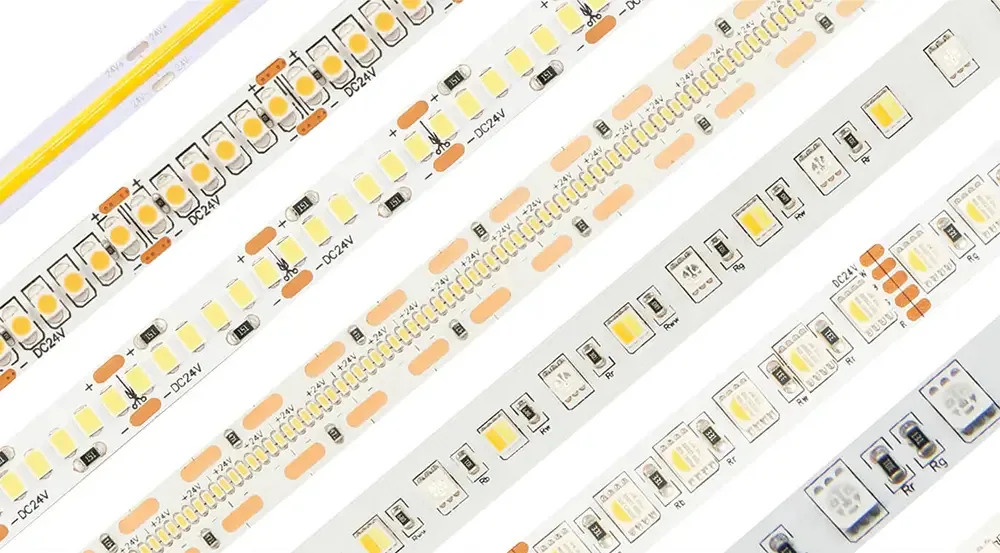
Scegliere la giusta larghezza della striscia LED garantisce che il vostro progetto di illuminazione sia pratico ed esteticamente gradevole. Pertanto, quando scegliete la larghezza della striscia LED, considerate i vincoli di spazio, la luminosità richiesta e l'uso previsto. Le strisce strette sono ideali per spazi ristretti, mentre quelle più larghe offrono una maggiore luminosità e sono perfette per aree più ampie. Pertanto, considerate attentamente i seguenti consigli:
1. Comprendere i requisiti del progettoPrima di selezionare la larghezza della striscia LED, valuta le esigenze specifiche del tuo progetto. Determina la posizione di installazione delle strisce LED. Hai bisogno di una striscia LED ultrasottile da 5 mm per spazi stretti o di una striscia LED più luminosa da 20 mm per aree più ampie?
2. Vincoli di spazio: Lo spazio disponibile gioca un ruolo cruciale nella scelta della larghezza appropriata. Per spazi compatti, come all'interno di mobili o sotto i ripiani, optate per larghezze più strette, come 8 mm o 10 mm. Questi profili sottili si integrano perfettamente in spazi ristretti senza apparire ingombranti.
3. Livello di luminosità richiesto: Anche il livello di luminosità richiesto dal progetto influenza la decisione. Strisce più larghe, come quelle da 15 mm e 20 mm, possono ospitare più LED per unità di lunghezza, garantendo una maggiore luminosità. Sono ideali per aree che richiedono un'illuminazione elevata, come cucine o luoghi di lavoro.
4. Requisiti specifici dell'applicazione: Considerare l'uso specifico della striscia luminosa a LED. Ad esempio, se si prevede di fornire illuminazione ambientale per un ambiente residenziale, una striscia luminosa da 10 millimetri potrebbe essere sufficiente. Tuttavia, per applicazioni commerciali che richiedono un'illuminazione stabile, strisce luminose più larghe potrebbero essere più appropriate.
5. Considerazioni sull'installazione: Non bisogna trascurare i requisiti di installazione (ad esempio, alimentazione e opzioni di installazione). Alcune strisce luminose più larghe, a causa del maggiore consumo energetico, potrebbero richiedere hardware o alimentazione aggiuntivi.
In sintesi, per scegliere la larghezza appropriata della striscia LED è necessario bilanciare lo spazio fisico, l'emissione luminosa richiesta e i fattori di installazione effettivi. Valutando questi aspetti, è possibile garantire che la scelta sia in linea con gli obiettivi funzionali ed estetici del progetto.
Le strisce LED più larghe consumano più elettricità?
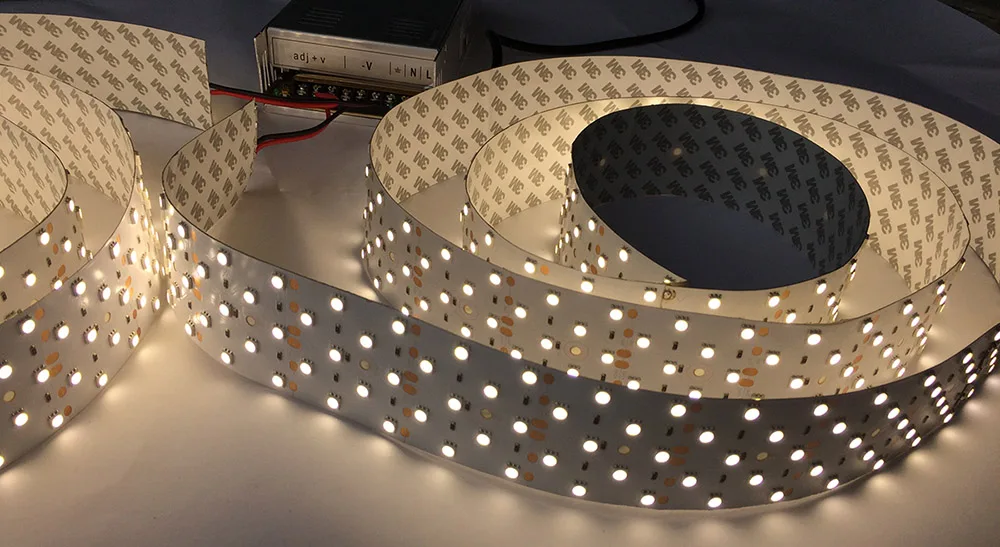
Le strisce LED più larghe non consumano necessariamente più elettricità. Questo dipende dalla densità dei LED, dalle dimensioni del chip, dalla qualità e dall'alimentazione. I motivi principali sono i seguenti:
- Tipo di chip LED: Il tipo e la qualità dei chip LED utilizzati nelle strisce luminose hanno un impatto significativo sul consumo energetico. A parità di luminosità, i chip LED più efficienti e avanzati consumano meno energia.
- Densità LED: Il numero di LED per unità di lunghezza influisce sul consumo energetico. Una maggiore densità di LED in genere significa più LED, con conseguente maggiore consumo energetico.
- Potenza nominale: La potenza nominale di una striscia luminosa a LED si misura in watt per metro (W/m), indicando la quantità di elettricità consumata per metro di striscia luminosa a LED. Una potenza nominale più elevata indica in genere un consumo energetico maggiore.
- Operativo Intensione: Anche la tensione di esercizio delle strisce LED influisce sul consumo energetico. Le strisce LED offrono in genere diverse opzioni di tensione, come 12 V CC o 24 V CC. Le strisce ad alta tensione spesso richiedono una corrente inferiore, il che le rende potenzialmente più efficienti dal punto di vista energetico.
Nello specifico, i chip LED più grandi consumano più energia. Ad esempio, una striscia LED SMD5050 da 10 mm consuma più energia di una striscia LED SMD2835 della stessa larghezza. Analogamente, se due strisce LED SMD2835 hanno la stessa densità, ma una è larga 5 mm e l'altra 10 mm, ciò non significa necessariamente che quella più larga consumi più energia. In questo caso, la larghezza della striscia LED non ha alcuna relazione diretta con il consumo energetico.
Per maggiori informazioni sulle strisce LED SMD2835 vs SMD5050, leggere “SMD3528 vs SMD2835 vs SMD5050: quale striscia LED è la migliore per l'illuminazione commerciale e architettonica?.”
Tuttavia, come ho già detto, le strisce LED con chip più grandi consumano più energia di quelle con chip più piccoli. Ma la differenza è minima. Ad esempio, per le strisce LED 2835 e 5050 con una densità di 60 LED al metro, il consumo energetico è il seguente:
| Chip LED | Potenza per chip | Potenza al metro (60LED/m Striscia LED) |
| SMD2835 | 0,2 W | 12W |
| SMD5050 | 0,24 W | 14,4 W |
Come mostrato nella tabella comparativa sopra, la differenza di potenza media per metro di striscia LED è di poco superiore a 2 watt. Sebbene questo influisca sul consumo energetico, non ha un impatto significativo sui calcoli dei costi a lungo termine.
Inoltre, maggiore è la densità della striscia LED, maggiore è la quantità di chip LED che richiede energia, con conseguente aumento del consumo energetico. In altre parole, una striscia LED larga 10 mm con 60 LED al metro consuma più energia di una striscia LED larga 10 mm con 30 LED al metro.
Pertanto, sebbene le strisce LED più larghe possano avere più LED e potenzialmente un consumo energetico maggiore, non è sempre così. È necessario considerare i fattori chiave sopra menzionati. Pertanto, assicuratevi di controllare le specifiche del prodotto e di selezionare le strisce LED che soddisfano i vostri standard di luminosità ed efficienza energetica.
Conclusione
Selezionare la larghezza appropriata della striscia LED è fondamentale per il successo del tuo progetto. Nella scelta, considera attentamente lo spazio, la luminosità e i requisiti applicativi. Ogni larghezza offre funzionalità distinte, che vanno dall'illuminazione d'accento delicata all'illuminazione intensa per ampie aree. In ogni progetto, i requisiti estetici o funzionali dipendono dalla scelta corretta della larghezza della striscia LED: dai modelli compatti da 8 mm alle larghezze maggiori, c'è sempre una soluzione per soddisfare tutte le tue esigenze.
Indipendentemente dalla larghezza delle strisce LED di cui hai bisogno per il tuo progetto di illuminazione, SignliteLED è la soluzione definitiva. Offriamo un'ampia varietà di Strisce luminose a LED SMD E Strisce luminose a LED COB per soddisfare le vostre esigenze. Inoltre, offriamo servizi di personalizzazione, OEM e ODM. Contattateci oggi stesso per ottenere la larghezza di striscia LED che desiderate!
